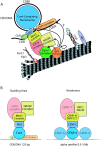Architecture of the budding yeast kinetochore reveals a conserved molecular core
- PMID: 14581449
- PMCID: PMC2173538
- DOI: 10.1083/jcb.200305100
Architecture of the budding yeast kinetochore reveals a conserved molecular core
Abstract
How kinetochore proteins are organized to connect chromosomes to spindle microtubules, and whether any structural and organizational themes are common to kinetochores from distantly related organisms, are key unanswered questions. Here, we used affinity chromatography and mass spectrometry to generate a map of kinetochore protein interactions. The budding yeast CENP-C homologue Mif2p specifically copurified with histones H2A, H2B, and H4, and with the histone H3-like CENP-A homologue Cse4p, strongly suggesting that Cse4p replaces histone H3 in a specialized centromeric nucleosome. A novel four-protein Mtw1 complex, the Nnf1p subunit of which has homology to the vertebrate kinetochore protein CENP-H, also copurified with Mif2p and a variety of central kinetochore proteins. We show that Mif2 is a critical in vivo target of the Aurora kinase Ipl1p. Chromatin immunoprecipitation studies demonstrated the biological relevance of these associations. We propose that a molecular core consisting of CENP-A, -C, -H, and Ndc80/HEC has been conserved from yeast to humans to link centromeres to spindle microtubules.
Figures





References
-
- Cheeseman, I.M., S. Anderson, M. Jwa, E.M. Green, J. Kang, J.R. Yates, C.S.M. Chan, D.G. Drubin, and G. Barnes. 2002. b. Phospho-regulation of kinetochore-microtubule attachments by the Aurora kinase Ipl1p. Cell. 111:163–172. - PubMed
-
- Cleveland, D.W., Y. Mao, and K.F. Sullivan. 2003. Centromeres and kinetochores: from epigenetics to mitotic checkpoint signalling. Cell. 112:407–421. - PubMed
Publication types
MeSH terms
Substances
Grants and funding
LinkOut - more resources
Full Text Sources
Molecular Biology Databases

